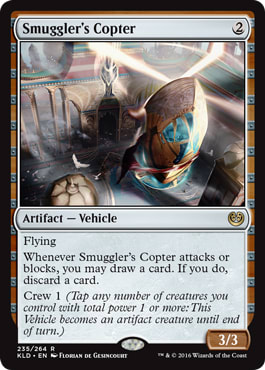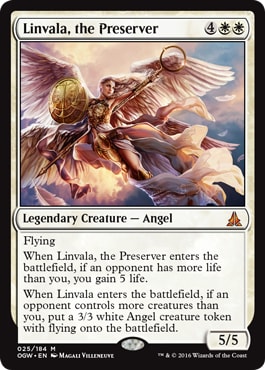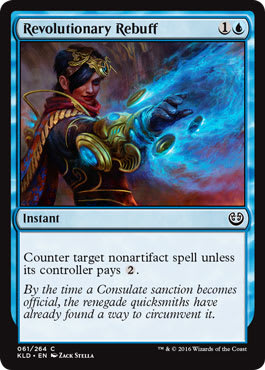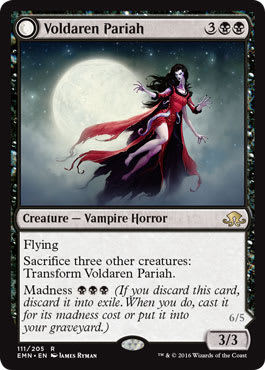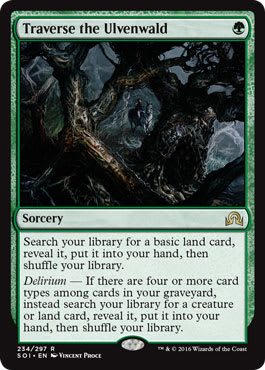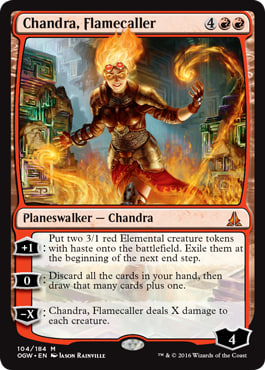In recent weeks, Standard has been in something of a state of suspended animation. For better or worse, StarCityGames Opens drive the metagame forward week-by-week by putting a substantial reward in front of the players who innovate and outperform the competition. That kind of incentive is actually anomalous in the history of competitive Magic, as for many years only Grand Prixs and Pro Tours offered a reward commensurate with metagame-shifting innovations. Obviously, we’ve become accustomed to the metagame moving faster and new “tech” cards quickly becoming obsolete in Standard. So what gives for this mini-lull?
Well, the most recent two weekends have seen Legacy and Modern Opens on the independent circuit, and before that, Santiago and Prague saw a Standard overrun with the same Ishkanah, Grafwidows and Smuggler's Copters that have dominated the conversation since Grand Prix Providence. Obviously there have been SCG Classic events, but those are significantly less likely to make noise in the metagame compared to the Opens. Small exceptions aside, it seems like Standard is locked in an arms race between U/W Flash and B/G Delirium, with aggressive Vehicles decks providing the “third party” option. Fortunately enough, third parties are much more likely to win a Magic tournament than a U.S. Presidential election, but there is still much to be said for picking a patron deck and prostrating yourself at the temple of the objective “best” choice.
Here’s your first option, B/G Delirium (this list courtesy of Bryan Carey, 3rd at the most recent Classic):
B/G Delirium ? Kaladesh Standard | Bryan Carey
- Creatures (16)
- 1 Emrakul, the Promised End
- 1 Kalitas, Traitor of Ghet
- 1 Noxious Gearhulk
- 2 Mindwrack Demon
- 2 Pilgrim's Eye
- 2 Tireless Tracker
- 3 Ishkanah, Grafwidow
- 4 Grim Flayer
- Planeswalkers (4)
- 4 Liliana, the Last Hope
- Spells (17)
- 2 Murder
- 3 Grapple with the Past
- 4 Grasp of Darkness
- 1 Ruinous Path
- 4 Traverse the Ulvenwald
- 3 Vessel of Nascency
- Lands (23)
- 6 Forest
- 7 Swamp
- 2 Evolving Wilds
- 4 Blooming Marsh
- 4 Hissing Quagmire
Most of the deck is fairly set in stone, though I like playing more Tireless Trackers when you can afford to. Three copies in the 75 seems about right, as the card is Courser of Kruphix-level powerful, though slightly slanted to be better against control than Aggro. I’d play something very, very close to this list in a tournament if I were interested in Spider staredowns and trying to break through with maindeck Noxious Gearhulk to give me an edge in Emrakul, the Promised End duels.
That being said, I don’t want massive staredowns in mirror matches, and I don’t want to risk unintentional draws any more than I have to. Gerry Thompson wrote about this deck in his article a few weeks back, and I’ve heard it called “The new U/W Delver” or “The new Caw-Blade” by more than one SCG grinder. Courtesy of Josh Cho, Chris Andersen, and Jack Kiefer, it’s Flash.
U/W Flash ? Kaladesh Standard | Josh Cho
- Creatures (20)
- 4 Archangel Avacyn
- 4 Reflector Mage
- 4 Selfless Spirit
- 4 Spell Queller
- 4 Thraben Inspector
- Planeswalkers (4)
- 4 Gideon, Ally of Zendikar
- Spells (11)
- 2 Revolutionary Rebuff
- 1 Declaration in Stone
- 4 Stasis Snare
- 4 Smuggler's Copter
- Lands (25)
- 10 Plains
- 7 Island
- 4 Port Town
- 4 Prairie Stream
- Sideboard (15)
- 2 Blessed Alliance
- 1 Negate
- 2 Scatter to the Winds
- 2 Spell Shrivel
- 2 Linvala, the Preserver
- 2 Jace, Unraveler of Secrets
- 2 Declaration in Stone
- 2 Fragmentize
Now, my favorite part of old Standard Delver decks wasn’t the dumb “hee-haw” draws that had you attacking for nine in the air on turn three. It wasn’t Geist of Saint Traft holding a Runechanter's Pike, or even my boo Snapcaster Mage. It was the beautiful transformational sideboard you got once Restoration Angel joined the team with Avacyn Restored. You could sideboard a pile of Day of Judgments, Timely Reinforcements, and a couple copies of Consecrated Sphinx. Your Mana Leaks and Snapcaster Mages looked just as great in Game 2 when they were countering threats while buying time for your Sphinx to come down as they did when they were countering answers and tempoing out your opponent in Game 1. Combine that with the fact that opponents would usually bring in cheap answers and sweepers to combat the blitzkrieg-style Game 1 game-plan, and you had a recipe for perfection.
Hey, you know what deck brings in lots of removal to try to keep a good Copter down? B/G Delirium, that’s what!
Now, we may never again experience the distinct pleasure of Snapcaster Mage-ing back a Mental Misstep in Standard, but Spell Shrivel on an Ishkanah while Jace, Unraveler of Secrets ticks up toward an impending victory is almost as sweet. Thraben Inspector is sort of like a cantripping Delver of Secrets that never flips (and let’s be real, it was always your opponent’s Delvers that flipped. Yours were generally glorified Wandering Ones.) Linvala, the Preserver is half-Timely Reinforcements, half-Consecrated Sphinx, and even the crappy Revolutionary Rebuff can pretend to be a Mana Leak if you believe hard enough. Just say “Mana Leak” every time you cast Rebuff, and maybe it’ll come true someday.
Hey, cut me some slack. The alternative is a Change.org petition, which might be even less realistic . . .
Let’s talk about some of the innovations, though, and where the deck is likely to move in the next few weeks. Revolutionary Rebuff is the obvious lynchpin that glues together a tempo gameplan in Game 1 with enough density of countermagic in the sideboarded games, and I congratulated Gerry Thompson on dusting off that particularly unsavory rock and finding a diamond in the rough. But how close is Rebuff to Leak, anyway? Talking to Gerry, I opined that it was 90% of a Mana Leak when people don’t know about it, but now that it’s been exposed like a Wikileaks story, it’s closer to 40% of a Mana Leak. He responded that he enjoyed when the answers were just a smidge narrower, as from a game design perspective, it promotes natural churn in decklists and prevents the format from getting super stale. Rune Snag and Mana Leak were a little too ubiquitous, and cards like Disdainful Stroke and Revolutionary Rebuff are the more interesting descendants. Even if they are a bit . . . castrated, they make for more interesting metagame decisions and in-game choices for how to best play around the commonly played counterspells. The same is true to a lesser extent with Spell Shrivel, although that particular card is much more likely to see play against B/G Delirium, and it’s much harder to wait out a Shrivel than a Rebuff. Two more land drops is a long, long time when you’re being smacked with a detective in a helicopter, and heaven forbid there’s a Gideon, Ally of Zendikar on the other side of the battlefield.
What comes next, though? I’d be interested in a single copy of Summary Dismissal making its way into the Flash sideboards as an answer to Emrakul, and I’d be thrilled to see a Key to the City or two in the 75. Key is an excellent way to filter past bad cards and ensure that you see all of your heavy hitters, and sneaking an Archangel Avacyn through an Ishkanah army just gives me a tingly feeling all over. Invisible Stalker might not have been a super-prevalent piece of Delver decks back in 2012, but I remember feeling pretty deflated whenever an opponent hooked up a Stalker with a Runechanter's Pike. Now you, too, can deflate your own opponents with a sneaky, unblockable creature while you hold up countermagic and loot past your excess lands.
Obviously my obsession with Key to the City borders on unhealthy, but I truly think it’s the poor man’s Smuggler's Copter that strands opponents’ removal in hand. We’ve already seen the next-level play of simply not Crewing the Copter when your opponent holds up a couple lands, thereby forcing them to either burn a removal spell on a crappy Inspector or Reflector Mage or waste their mana for that turn. Now imagine that, but with a card that both filters your draws, allows you to Madness out threats at instant speed, doesn’t force you to play in a particular pattern, and makes your crappy creatures must-answer threats via unblockability.
Call me crazy, but I think R&D was listening to DJ Khaledesh’s latest album when they were designing this set:

So far, it seems like only Platinum Pro Steve Rubin has been sitting in DJ Khaled’s throne lately, because unlike most others, he has played (and continues to play) decks with a copy or two of Key to the City over the last month. Let’s take a look at a deck that could potentially unseat the current top dog, Steve’s U/B Zombies:
U/B Zombies ? Kaladesh Standard | Steve Rubin
- Creatures (22)
- 2 Mindwrack Demon
- 4 Cryptbreaker
- 4 Haunted Dead
- 4 Prized Amalgam
- 4 Scrapheap Scrounger
- 4 Voldaren Pariah
- Planeswalkers (2)
- 2 Liliana, the Last Hope
- Spells (12)
- 4 Grasp of Darkness
- 2 Sinister Concoction
- 2 Key to the City
- 4 Smuggler's Copter
- Lands (24)
- 1 Island
- 15 Swamp
- 4 Choked Estuary
- 4 Sunken Hollow
- Sideboard (15)
- 2 Distended Mindbender
- 1 Dead Weight
- 1 Murder
- 1 Negate
- 2 Spell Shrivel
- 2 Skysovereign, Consul Flagship
- 2 Kalitas, Traitor of Ghet
- 1 Collective Brutality
- 1 Lost Legacy
- 1 Pick the Brain
- 1 Ruinous Path
This is actually very similar to the deck that Philippe Gareau and I spent most of our pre-PT Kaladesh testing working on, although we had a few copies of Distended Mindbender in our maindeck and used Weaponcraft Enthusiast as food for the Mindbender, fodder for Voldaren Pariah, crew for the Copter, and fertilizer for regrowing our Scrapheap Scroungers. It was surprisingly good, although I understand the need for a big flying body in Mindwrack Demon instead of the synergistic Servo maker. Either way, this deck is super sweet. Key and Copter dig you past lands and keep you well-gassed, as well as giving you madness outlets for Voldaren Pariah. There’s just one problem . . .
Your removal kind of sucks, and you don’t have big Ishkanah to brickwall opposing aggressive creatures. Steve was dipping deep enough to play Sinister Concoction, which is understandable, but not thrilling. I’d love to play a deck with better removal in Fiery Temper (which, incidentally, gets along with Key to the City just fine) in order to make it more likely that you can do two things in one turn. You almost need to play Grasp of Darkness in order to cleanly answer Archangel Avacyn and Selfless Spirit, though. If you do that, you have to contend with a Gideon emblem making your removal look embarrassing. White actually has the best clean removal in Stasis Snare and Declaration in Stone, which is . . . anomalous, to say the least. See what Gerry was talking about when he explained how the churn of answers and threats makes a format dynamic?
Now, we all recognize that when a format starts to congeal, to become predictable, there is the opportunity for innovation. I want to explore a deck that exploits the one good sweeper left in Standard, Kozilek's Return. Return’s front end actually does great work against Vehicles, and the back end is an instant-speed (with Elder Deep-Fiend) sweeper that answers just about every commonly played creature in Standard. One deck that I’ve seen that excites me like no other is Four-Color Emerge:
4-Color Emerge ? Kaladesh Standard | Ben Friedman
- Creatures (25)
- 1 Mindwrack Demon
- 1 Noose Constrictor
- 3 Grim Flayer
- 4 Elder Deep-Fiend
- 4 Haunted Dead
- 4 Minister of Inquiries
- 4 Prized Amalgam
- 4 Scrapheap Scrounger
- Spells (12)
- 1 Grapple with the Past
- 3 Kozilek's Return
- 4 Traverse the Ulvenwald
- 4 Smuggler's Copter
- Lands (23)
- 1 Forest
- 1 Mountain
- 2 Island
- 2 Swamp
- 2 Aether Hub
- 3 Blooming Marsh
- 4 Botanical Sanctum
- 4 Evolving Wilds
- 4 Sunken Hollow
To be fair, I’d maindeck an Ishkanah in order to have an additional board-clogger against aggressive decks, since you can’t count on hitting a Kozilek's Return every time. Having Ishkanah as a tutor target via Traverse the Ulvenwald helps immensely in the whole “not dying” business, and it forces your opponent to expend their resources in answering the Ishkanah. The extra time should give you breathing room to set up your endgame Elder Deep-Fiend chains.
This deck is not for the faint-hearted, and the prevalence of exile-based removal in the most popular deck makes me a little skeptical to rely on a graveyard deck with an Elder Deep-Fiend endgame. A single Declaration in Stone can unravel your entire gameplan, and you’re not going to be able to keep your opponent off of a single two-mana spell with a Deep-Fiend trigger.
If Emerge is experimental, and dangerous enough to reconsider with every new enabler, fixer, or payoff card in the next few sets, Aetherworks Marvel is even closer to the breaking point of Standard. It’s ironic, actually, that this Standard format started out with a spell that basically targeted Aetherworks Marvel as the best reason to play Blue, and now has shifted so dramatically that the preferred cheap maindeck counterspell can’t actually counter Marvel. That . . . presents us with an opportunity. Aetherworks Marvel has always had a strategic advantage against the plodding, midrange-y Delirium deck, and if Marvel can sort of imitate a Delirium deck against Flash, it should be advantaged against both poles of the format. But how do you get an all-in combo deck to act like a Delirium deck against the premier aggro-control deck of the format? Well, you play Ishkanah and more medium-Marvel hits, and you pack a full complement of Tears of Valakut in your sideboard to answer Spell Queller.
R/G Marvel ? Kaladesh Standard | Ben Friedman
- Creatures (12)
- 1 World Breaker
- 3 Ishkanah, Grafwidow
- 4 Emrakul, the Promised End
- 4 Servant of the Conduit
- Planeswalkers (2)
- 2 Chandra, Torch of Defiance
- Spells (24)
- 2 Kozilek's Return
- 4 Harnessed Lightning
- 2 Cathartic Reunion
- 4 Attune with Aether
- 4 Vessel of Nascency
- 4 Aetherworks Marvel
- 4 Woodweaver's Puzzleknot
- Lands (22)
- 3 Mountain
- 8 Forest
- 1 Wastes
- 2 Evolving Wilds
- 4 Aether Hub
- 4 Game Trail
- Sideboard (15)
- 4 Tireless Tracker
- 2 Kozilek's Return
- 1 Nissa, Vital Force
- 4 Tears of Valakut
- 4 Thought-Knot Seer
If U/W Flash is the spiritual successor to U/W Delver, this is basically a weird Kaladesh-ized version of the Primeval Titan-Valakut archetype of the very same Standard format. I think there’s something there, but I’m interested in some number of Chandra, Flamecaller, as well as potentially Nissa's Renewal to bridge to naturally-cast Emrakuls. A copy or two of Ulamog, the Ceaseless Hunger wouldn’t be so out of place in the sideboard, especially considering that B/G Delirium may try to pick out all of your Emrakuls and strand you without many “real” Marvel hits. Ulamog does a pretty nice job of presenting additional Marvel hit density, and it can even exile an Emrakul from B/G’s side. Don’t laugh, you often find yourself in dueling Emrakul scenarios, and a hardcast or Marvel-cast Ulamog would put you way ahead in situations where you’d ordinarily be behind.
Look. I’m not going to sugarcoat it. Standard is close to the point where a U/W deck pushes the rest of the format around in circles, but we haven’t gotten there quite yet. Both Delirium and U/W warp the format, but this is still a binary star system, not a one-deck black hole format. Zombies, Cars, and Marvels all have angles to attack the most-played archetypes, and I fully expect the format to develop more before Aether Revolt comes and shakes everything up again next year.













